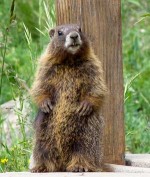
Yellow-bellied marmots in Colorado are gaining weight and producing more offspring compared to thirty years ago. The difference is attributed to climate change.
In the Rocky Mountains, these marmots usually hibernate for seven to eight months of the year, which make the summer months “a very busy time for them,” Arpat Ozgul, of the Department of Life Sciences at Imperial College London and lead author of the new paper, said in a prepared statement. “They have to eat and gain weight, get pregnant, produce offspring and get ready to hibernate again.”
But as the Colorado summers have grown longer, so too has the time the marmots have to do all of these things—and do them better. This extra preparation (and reproduction) time means that “they are more likely to succeed and survive,” said Ozgul, whose results were published online July 21 in the journal Nature (Scientific American is part of Nature Publishing Group).
As the marmots grow bigger, other species are not doing as well. The number of tall bluebells and tenacious wolverines has declined.
 Yellow-bellied marmots in Colorado are gaining weight and producing more offspring compared to thirty years ago. The difference is attributed to climate change.
Yellow-bellied marmots in Colorado are gaining weight and producing more offspring compared to thirty years ago. The difference is attributed to climate change.
No comments:
Post a Comment